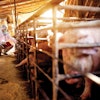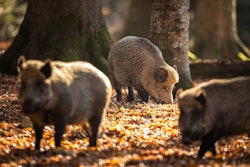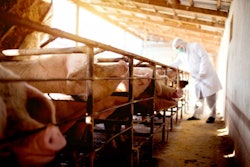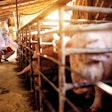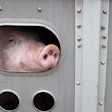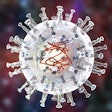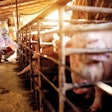
Line speeds, Prop 12 and trade among the top issues for US pork producers
The National Pork Producers Council (NPPC) has a full plate of legislative priorities, which it outlined during the first day of World Pork Expo in Des Moines, Iowa.
Among those priorities are New Swine Slaughter Inspection System (NSIS) line speeds, California’s Proposition 12 ballot initiative, international trade, labor reform, the industry’s carbon footprint and foreign animal disease prevention.
World Pork Expo is underway this week at the Iowa State Fairgrounds for the first time since 2018. The event was canceled in 2019 due to concerns about African swine fever (ASF) and in 2020 because of the COVID-19 pandemic.
NSIS line speeds
A federal judge recently struck down a provision of the U.S. Department of Agriculture’s (USDA) NSIS that allowed for faster harvest facility line speeds. NPPC has asked the USDA and the U.S. Department of Justice to appeal that ruling, which it says will cause “tremendous financial harm to American hog farmers” when it is set to take effect on June 29. NPPC also says the ruling will lead to a 2.5% loss in pork packing plant capacity nationwide and more than US$80 million in reduced income for small U.S. hog farmers.
NSIS has been evaluated at five pilot plants throughout the past 20 years and was approved for industrywide adoption in 2019.
“The five original plants, which had been running at NSIS line speeds over the life of the program, have been safely operating for more than 20 years,” said NPPC President Jen Sorenson. “At a time when the United States is seeking to increase much-needed pork harvest capacity, the court order will reduce plant capacity at six plants running NSIS line speeds by as much as 25%.”
Nick Giordano, NPPC’s vice president and counsel, said the issue with the ruling on NSIS line speeds is due to a legal technicality, not worker safety.
“The data, in fact, don’t suggest higher levels of worker injury. They suggest lower levels of worker injuries at these plants,” he said. “The reason that the federal district judge in Minnesota struck down the rule with regard to line speeds was a legal technicality under the Administrative Procedure Act,” which governs the ways federal agencies develop and issue regulations.
“Of course we’re for worker safety, not only in the plants, but also on the farms. There’s an outcome here where everybody can be happy,” he added.
Prop 12
Sorenson said NPPC is challenging California’s Proposition 12 ballot initiative “on several fronts.”
The initiative, which establishes new standards for animal housing and was passed in 2018, “imposes arbitrary animal housing standards that reach far outside the state’s borders to farms across the country. Its impact is likely to include significantly increased costs for producers and consumers,” she said.
NPPC and the American Farm Bureau Federation have filed a lawsuit in the U.S. Court of Appeals for the Ninth Circuit asking for it to strike down Prop 12 as unconstitutional under the Dormant Commerce Clause, which prohibits state legislation from discriminating against interstate commerce. A court ruling is expected this summer.
Sorenson cited a recent financial analysis that found that “Prop 12-related compliance costs will lead to the loss of small hog farms and further consolidation of our industry.”
International trade
“Trade will always be a top issue for U.S. pork producers,” Sorenson said, pointing to several opportunities in the Asia-Pacific region.
While the Biden administration is not expected to act on the Comprehensive and Progressive Agreement for Trans-Pacific Partnership (CPTTP) in the near future, “longer term, NPPC has its sights set on U.S. entry into the CPTTP trade agreement, which currently includes as signatories multiple large pork-consuming nations,” she said. “China continues to struggle with African swine fever and, while U.S. pork exports to China have increased, (punitive) tariffs put the U.S. pork industry at serious disadvantage as the world’s largest pork-consuming nation seeks reliable sources of pork.”
Giordano said those tariffs take away value from U.S pork producers.
“For the punitive tariffs that have been on our product … we’re at 33%, most of the rest of the world is at 8%. Obviously, we’re leaving value on the table,” he said.
Sorenson said NPPC is also focused on more immediate export opportunities, such as to the Philippines and Vietnam.
“Vietnam represents a tremendous opportunity for U.S pork,” she said.
Labor reform
Sorenson said labor shortages in the ag sector challenge the industry’s profitability.
“The renewed attention of the Biden administration to bringing immigration reform is a welcome development for livestock agriculture. Livestock agriculture is suffering from a serious labor shortage, which is negatively impacting the entire supply chain, from farms all the way to harvest facilities. This challenge undermines a critical economic sector that, in recent years, has driven employment and wage growth back to the overall economy and is the key to prosperity in rural America.”
Additionally, because pork producers are largely reliant on foreign farm workers, NPPC seeks reforms to the H2A visa program so that it can be applied to nonseasonal livestock agriculture, instead of only seasonal work.
Carbon footprint
NPPC supports several initiatives to further reduce the industry’s carbon emissions, Sorenson said.
“Climate change and other environmental policies are also at the top of the Biden administration agenda. U.S. pork producers have a great story to tell, and we welcome the chance to contribute to these policy discussions,” she said. “Over the last 50 years, while doubling the amount of pork produced from 12 billion pounds in 1960 to 24 billion pounds today, the U.S. pork industry now uses 76% less land, 25% less water and 7% less energy to produce pigs. This has also resulted in a 7.7% smaller carbon footprint.”
Foreign animal disease prevention
Sorenson said NPPC is working to improve biosecurity to protect the U.S. swine herd from foreign animal diseases.
“With African swine fever so prominent in the Asia-Pacific region, NPPC is not letting its guard down when it comes to further strengthening biosecurity defense at our borders. We have made considerable progress,” she said.
NPPC Chief Veterinarian Liz Wagstrom said countries that have been dealing with ASF can teach valuable lessons to countries such as the U.S. which remains free from ASF.
“What we have done is look at the whole of Southeast Asia and said, ‘What can we learn from Southeast Asia to help us be better prepared to prevent and respond in the case of disease?’” she said. “While we are concerned about the ongoing situation in Asia, where we can collaborate across countries to be able to get ourselves better prepared, we’re working on that.”
World Pork Expo continues through June 11.
